The 1990s: Innovation with ONCE
The 1990s: Innovation with ONCE
by Ander Izagirre
Manolo Saiz remembers the day he walked into the Etxeondo farmhouse and opened the boxes of clothing for the team he had just created.
– At that moment I realized that ONCE was a reality. It was a very physical sensation: opening the boxes, touching the clothes, smelling them… In the following days I handed them out to the cyclists, so we began to dream.
The dreams came true quickly. In the first stage of the 1989 Tour of the Basque Country, two ONCE riders took the first places: Johnny Weltz and Peio Ruiz Cabestany. Paco Rodrigo, founder of Etxeondo, showed up at the start of the next stage with more boxes.
– That’s when I realized how Paco took care of his teams,” says Saiz. That morning it was pouring down and he came with the best rain jackets and rain boots, the riders were delighted.
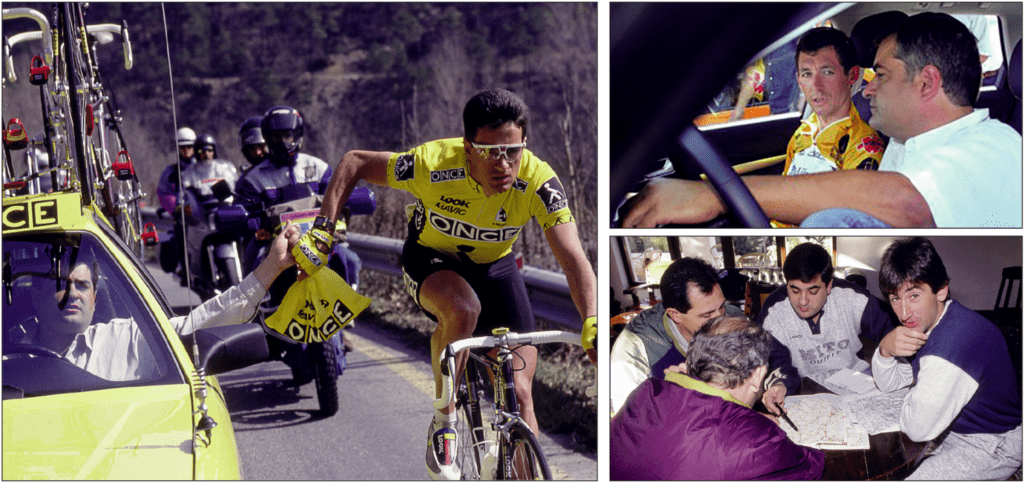

Manolo Saiz, born in Torrelavega (Cantabria) in 1959, was a physical trainer who never imagined himself as a sports director. His cycling project was based on innovation: he innovated training sessions, materials, team design and race strategy. To innovate in clothing, he found the complicity of Etxeondo. And the way to deploy his ideas was the creation of the ONCE team. He counted on cyclists such as Eduardo Chozas, whom he had already trained in 1980, when Chozas was a neo-professional and Saiz a second-year student at the National Institute of Physical Education (INEF) in Madrid.
– At that time, the cyclists would get up in the morning, see if it was good, meet up with their mates and go out for a 100 or 120 km ride without any plan,” says Saiz. At least they would ride up a mountain or sprint to the signpost of a town, that helped them, intuitively. I used to train when I was a kid, 16 or 17 years old, when I was a youth, and sometimes we would get together with González Linares’ group. I remember the scolding he gave me once to get in front of him and take the wind out of his sails. Look at him, a fully-fledged professional, one who beat Merckx in time trials… That was the idea of training.
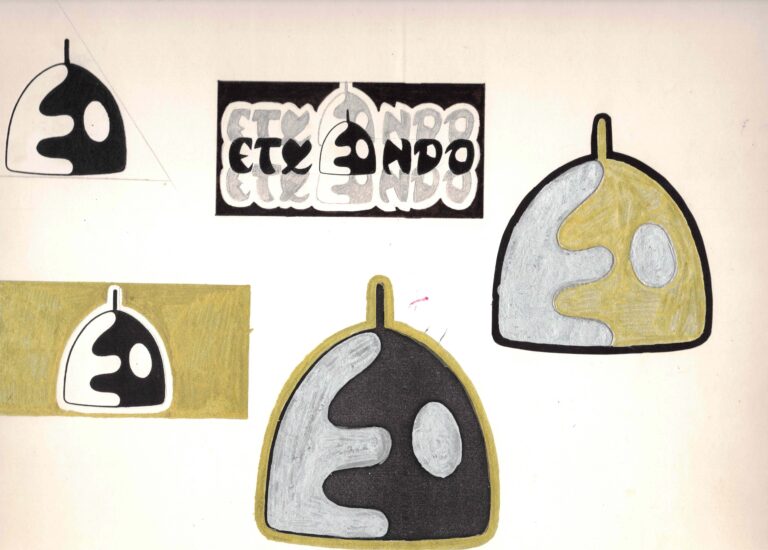

At INEF, Saiz discovered a valuable resource:
– A large library with translators. If you were interested in an article from a foreign magazine or book, they would translate it for you. I read a lot about training methods from the Soviet Union, from East Germany, which were the most advanced countries.
Saiz began to train cyclists from Cantabria who had raced with him up to the youth level and cyclists from Madrid.
– We would meet at the Casa de Campo for training sessions, and then they would come to INEF to do exercises in the gym. There the cyclists would meet up with Real Madrid basketball players, athletes, handball players, and they would learn from other sportsmen and women, which was something new.
At INEF, Saiz discovered a valuable resource:
– A large library with translators. If you were interested in an article from a foreign magazine or book, they would translate it for you. I read a lot about training methods from the Soviet Union, from East Germany, which were the most advanced countries.
Saiz began to train cyclists from Cantabria who had raced with him up to the youth level and cyclists from Madrid.
– We would meet at the Casa de Campo for training sessions, and then they would come to INEF to do exercises in the gym. There the cyclists would meet up with Real Madrid basketball players, athletes, handball players, and they would learn from other sportsmen and women, which was something new.



Until then, winter was a time of rest… and neglect.
– They hung up their bikes, ate chops and potatoes with chorizo and arrived at the Ruta del Sol with three hundred kilometres of training and twelve extra kilos. The first races of the year were always won by foreigners, because they prepared the classics and went out to train in cold, wet or snowy conditions, it didn’t matter to them. The Spaniards, if it rained, stayed at home.
Saiz prepared winter training sessions for his riders, apart from cycling.
– We would go to the beach at Suances or Liencres and do multi-jumps on the sand, at different heights in the water, in the stands. We did continuous running, gymnastics, weights, and so on until 15 or 20 December.
They hung up their bikes, ate chops and potatoes with chorizo and arrived at the Ruta del Sol with three hundred kilometres of training and twelve extra kilos.



Was there any reticence in the cycling world?
– Yes, especially from the veteran directors. Cyclists only had to pedal and accumulate kilometres, they thought that the beach and the gym were a joke. My immense good fortune was to have cyclists like Rupérez and Chozas, who were very disciplined. The directors themselves were surprised to see Chozas in the first races of the year: “Hey, you’re so thin!”
In January 1983, after some demanding winter training, Chozas covered a lot of kilometres on the Vespa driven by Manolo Saiz.
– I missed a lot of classes to go out and train with him,- he laughs.
And Chozas started the season winning everything at the age of just 22: the Vuelta a Andalucía, the Camp de Morvedre trophy, the Sabiñánigo trophy… He finished sixth in the Vuelta a España and eighth in the Giro, with a stage win. At that time it was usual for cyclists to chain races one after the other. Saiz says that when they planned their training sessions, they also planned the season: the moments to train endurance, strength, peaks, rests…
Play Video
– I would prepare mini-seasons for them within a season. A coach thinks about the present and the future: if he’s 22 years old, I’ll train him like this, next year when he’s 23 he’ll be like this, when he’s 25 he’ll be like this… In the end, you plan a sporting life.
In that successful 1983, Chozas rode with Zor: the first professional team, together with Reynolds, dressed by Etxeondo. Manolo Saiz knew about Paco Rodrigo’s work with the teams of the 80s and when he set up ONCE, he commissioned him to provide the clothing.
– Paco always knew the best materials, the latest fibre that had just come out. I really liked the way he perfected every detail. We got on very well. I remember that winter garment with a hood, it was the change from wool to fibre, which was lighter and warmer, we started with goretex… And that overalls for the cyclists to recover after the stages!
– I prepared a special black overall, with thermolite, a hollow fibre, to keep them warm,- explains Paco Rodrigo. As soon as the race was over, the cyclists wore it until they got to the shower and the massage.
– He was a very good diver,- continues Saiz. There is a psychological part to all this: you sell it to the riders, you explain to them that they are in the team that recovers the best, when they arrive at the finish line they immediately have the right food and drink, we give them the overalls to maintain their body temperature, because that way the blood flow flows better… I explained to the riders why we did each thing and that really got through to them. The cyclists were in love with Paco’s new products.
– I would prepare mini-seasons for them within a season. A coach thinks about the present and the future: if he’s 22 years old, I’ll train him like this, next year when he’s 23 he’ll be like this, when he’s 25 he’ll be like this… In the end, you plan a sporting life.
In that successful 1983, Chozas rode with Zor: the first professional team, together with Reynolds, dressed by Etxeondo. Manolo Saiz knew about Paco Rodrigo’s work with the teams of the 80s and when he set up ONCE, he commissioned him to provide the clothing.
– Paco always knew the best materials, the latest fibre that had just come out. I really liked the way he perfected every detail. We got on very well. I remember that winter garment with a hood, it was the change from wool to fibre, which was lighter and warmer, we started with goretex… And that overalls for the cyclists to recover after the stages!
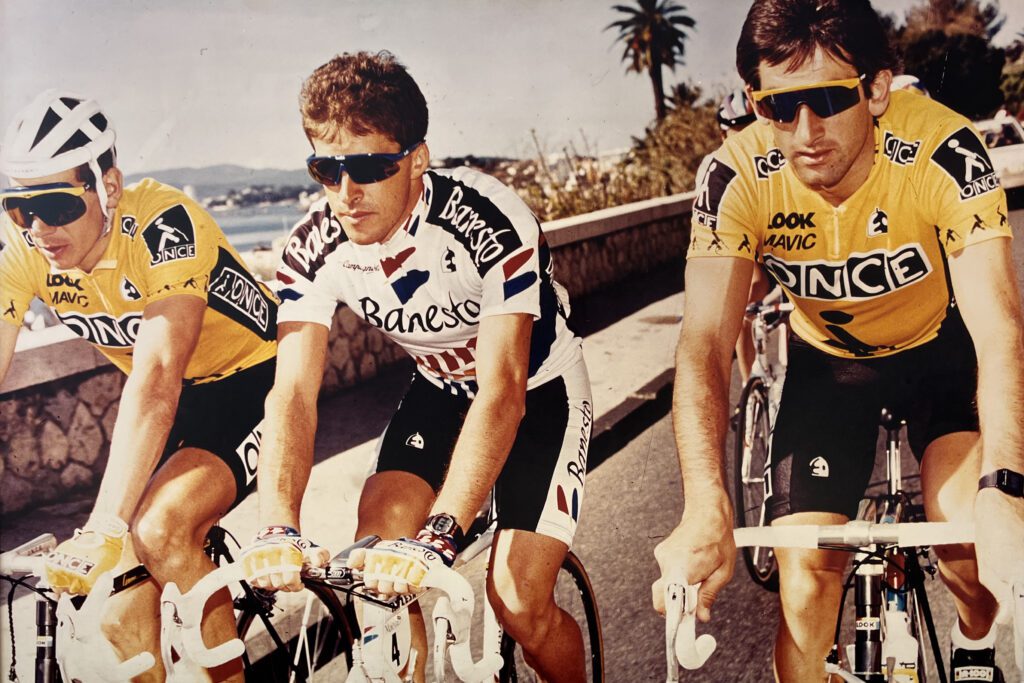


– I prepared a special black overall, with thermolite, a hollow fibre, to keep them warm,- explains Paco Rodrigo. As soon as the race was over, the cyclists wore it until they got to the shower and the massage.
– He was a very good diver,- continues Saiz. There is a psychological part to all this: you sell it to the riders, you explain to them that they are in the team that recovers the best, when they arrive at the finish line they immediately have the right food and drink, we give them the overalls to maintain their body temperature, because that way the blood flow flows better… I explained to the riders why we did each thing and that really got through to them. The cyclists were in love with Paco’s new products.



In the time trials all the teams went out with short overalls,- continues Saiz,-and we started with long-sleeved overalls, with that detail of the hole to put the thumb in so we could always wear it stretched out, without a fold, as aerodynamic as possible....
– I used to prepare mini-seasons for them within a season. A coach thinks about the present and the future: if he’s 22 years old I’ll train him like this, next year when he’s 23 he’ll be like this, when he’s 25 he’ll be like this… In the end you plan a sporting life.
In that successful 1983, Chozas raced with Zor: the first professional team, together with Reynolds, dressed by Etxeondo. Manolo Saiz knew Paco Rodrigo’s work with the teams of the 80s and when he set up ONCE he commissioned the clothing from him.
– Paco always knew the best materials, the latest fiber that had just come out. I really liked the way he perfected every detail. We understood each other very well. I remember very well that winter garment with hood, it was the change from wool to fiber, which was lighter and warmer, we started with goretex… And that overalls for cyclists to recover after the stages!
– I prepared a special black overall, with thermolite, a hollow fiber, to keep them warm,” explains Paco Rodrigo. As soon as the race was over, the cyclists wore it until they got to the shower and the massage.
– He was a very good diver -Saiz continues-. There is a psychological part in all this: you sell it to the riders, you explain to them that they are in the team that recovers the best, when they arrive at the finish line they immediately have the right food and drink, we give them the overalls to maintain their body temperature, because that way the blood flow flows better… I explained to the riders why we were doing each thing and that really got through to them. The cyclists were in love with Paco’s new products.
The overalls were so comfortable and pleasant that some of them went out to train with them. Saiz told them no, that they could wear it on a light ride but not on long training rides. Each garment was designed for its moment.
– In the time trials all the teams went out with short overalls,” Saiz continues, “and we started with long-sleeved overalls, with that detail of the hole to put the thumb in so they could always wear it stretched out, without a fold, as aerodynamic as possible….
– We talked a lot about clothes,” says Paco Rodrigo. Manolo would press me, he wanted me to find the best for him. Maybe we were having dinner, he would say something, I wouldn’t say anything but I would start thinking about the idea…
– Once I told you about the overalls the Russians used to wear in the velodrome, Ekimov and all those, do you remember, Paco? Those red overalls so bright, they looked like plastic. I told you that nobody had ever used that fabric again.
– I made them for you for the first time for a Tour, for a time trial in which it was terribly hot?
– For the prologue of Puy-du-Fou.
– That one. I managed to print the overalls, which was not at all easy with that fabric, and I thought: let’s see what happens when they are stretched, let’s see how they look, let’s see how they fit?
– We went out with those long bubblegum pink overalls and the Lotus bikes.
ONCE had four riders in the top thirteen: Zülle was second, Jalabert ninth, Bruyneel twelfth and Breukink thirteenth.
The overalls were so comfortable and pleasant that some of them went out to train in them. Saiz told them no, that they could wear it on light outings but not on long training sessions. Each garment was designed for its own moment.
– In the time trials, all the teams went out with short overalls,- Saiz continues, -and we started with long- sleeved overalls, with that detail of the hole to put the thumb in so that we could always wear it stretched out, without a fold, as aerodynamic as possible….
– We talked a lot about clothes,- says Paco Rodrigo. Manolo would press me, he wanted me to find the best for him. Maybe we’d be having dinner, he’d say something, I wouldn’t say anything but I’d start thinking about it…





– I once told you about the overalls the Russians used to wear in the velodrome, Ekimov and all those, do you remember, Paco? Those bright red overalls that looked like they were made of plastic. I told you that nobody had ever used that fabric again.
– I made them for you for the first time for a Tour, for a time trial where it was terribly hot?
– For the prologue of Puy-du-Fou.
– That one. I managed to print the overalls, which wasn’t at all easy with that fabric, and I thought: let’s see what happens when they stretch them, let’s see how they look, let’s see how they fit…
– We went out with those long, bubblegum pink overalls and the Lotus bikes.
ONCE had four riders in the top thirteen: Zülle was second, Jalabert ninth, Bruyneel twelfth and Breukink thirteenth.



– But there was always one who won the Tour prologue for us by a hair’s breadth,- laughs Saiz.
He is referring, of course, to Miguel Induráin. The year before, in the 1992 Tour prologue in San Sebastian, the Navarrese beat Zülle by two seconds. It was a big blow for ONCE, says Saiz, but the next day there was a flying finish with points and bonuses in Zarautz, in the first kilometers of the stage, and they looked for a way to get the yellow jersey.
– I got along very well with the riders of other teams, they had my help when they needed it, the usual, the usual cycling agreements. At the start I spoke to Cipollini, who was the leader of the sprinters: “Look, Mario, Zülle is going to attack at the top of Orio to get the bonus in Zarautz. I ask you not to go for him, you sprint for second place and thus prevent Miguel from taking seconds“. I don’t think Miguel would have sprinted, but he had to foresee everything, just in case.
Saiz was working hard on his strategy, looking for any point where he could make a surprise, get an advantage, but he knew that cycling is unpredictable.
– Zülle already had the seconds for the yellow jersey, but suddenly a shoe started to give him problems, halfway through the stage he took it off and put on one of his teammate Xabier Aldanondo’s, which was a similar size, they had to climb Jaizkibel… He saved the day, but what an ordeal.
ONCE had some of the most outstanding cyclists on the world scene (Lejarreta, Mauri, Zülle, Jalabert, Beloki…) but it formed, above all, fearsome blocks: they won the team time trials, attacked in spurts from afar with several riders at once, as in the legendary mid-mountain stage of Mende in the 1995 Tour: Stephens, Mauri and Jalabert reached ten minutes ahead, put the Banesto team of leader Induráin in trouble and in the end cut five minutes off. Zülle took second overall, Jalabert third and Mauri fifth: they never managed to topple Induráin, but they unleashed their collective strength for some of the most exciting battles of those years.
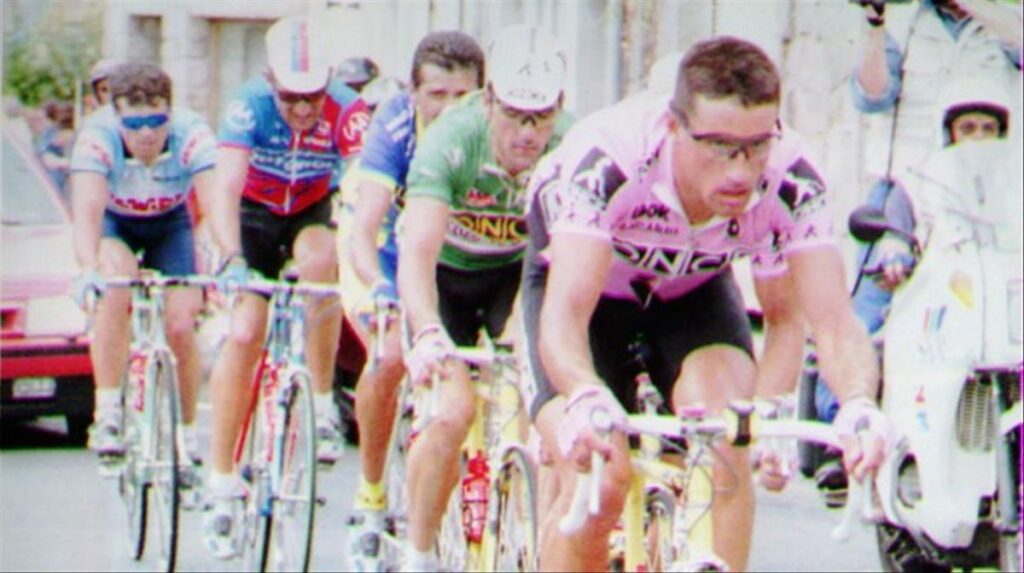


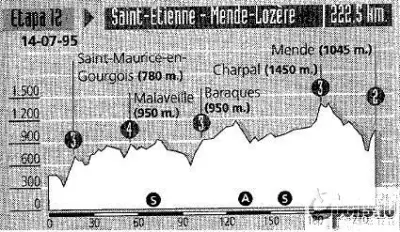


– When I came to cycling, the teams had a leader and all the others were pure and hard gregarious, who earned the minimum and always worked at the service of the leader, without any personal ambition. I wanted to do team cycling: we had our leaders, but all the riders were important. I treated everyone equally, everyone had their chances during the year, so the team worked much better. We won races with Zülle and Jalabert, but also with Díaz Zabala, Iñigo Cuesta, Neil Stephens…. I wanted everyone to perform at their best.
– ONCE was the team with the best image,- says Paco Rodrigo. Because their director was the most daring, they worked as a block, they marked how they ran… They did great marketing, but not with words but with actions. That was noticeable, I sold thousands of ONCE garments.
THAT THE JERSEY LOOKS GOOD AND THAT THE CYCLISTS WIN
The ONCE jersey was one of the iconic jerseys of the peloton in the 1990s. The Spanish National Organization for the Blind (ONCE) was a powerful company and had its brand book, its corporate image well defined, which was unusual in those years. But it clashed with some of the ideas Etxeondo had for the jersey.
– I used to watch TV a lot, looking at how the jerseys looked in the peloton, with the speed, with the light… ONCE had green and yellow as brand colors, but that didn’t look good on TV, we needed something sharper. I designed a jersey with a very clear yellow color, very clean, with white letters on black backgrounds that looked great… And then Manolo sold the bike very well to the sponsor.
– I sold him the bike because María Jesús and Paco had explained everything to me. With them I learned a thousand things about colors, fabrics, elasticity, cuts, all the technical aspects of clothing. I explained to the ONCE bosses that a yellow jersey looked much better, that the black and white were the positive and the negative, that they made contrast, that on the sides we had the five squares with the four letters of ONCE and the pictogram of the blind, as their corporate image marked, but that on the chest it was cleaner to put only the four squares of the letters and the pictogram below in large…
– But there was always one who would win the Tour prologue for us by a hair’s breadth,- laughs Saiz.
He is referring, of course, to Miguel Induráin. The year before, in the 1992 Tour prologue in San Sebastian, the Navarrese rider beat Zülle by two seconds. It was a big blow for ONCE, says Saiz, but the next day there was a flying finish with points and bonuses in Zarautz, in the first kilometres of the stage, and they looked for a way to get the yellow jersey.
– I got on very well with the riders from other teams, they had my help when they needed it, the usual cycling agreements. At the start I spoke to Cipollini, who was the leader of the sprinters: “Look, Mario, Zülle is going to attack at the top of Orio to get the bonus in Zarautz. I ask you not to go for him, you sprint for second place and thus prevent Miguel from taking seconds“. I don’t think Miguel would have sprinted, but he had to foresee everything, just in case.
Saiz was working hard on his strategy, looking for any point where he could make a surprise, where he could gain an advantage, but he knew that cycling is unpredictable.
– Zülle already had the seconds for the yellow jersey, but suddenly a shoe started to give him problems, halfway through the stage he took it off and put on one of his teammate Xabier Aldanondo’s shoes, which was a similar size, they had to climb Jaizkibel… He saved the day, but what an ordeal.
ONCE had some of the most outstanding cyclists on the world scene (Lejarreta, Mauri, Zülle, Jalabert, Beloki…) but it formed, above all, fearsome blocks: they won the team time trials, they attacked in spurts from afar with several riders at the same time, as in the legendary mid-mountain stage of Mende in the 1995 Tour: Stephens, Mauri and Jalabert reached ten minutes ahead, they put the Banesto team of leader Induráin in trouble and in the end they cut five minutes off the lead. Zülle took second overall, Jalabert third and Mauri fifth: they never managed to topple Induráin, but they unleashed their collective strength for some of the most exciting battles of those years.





